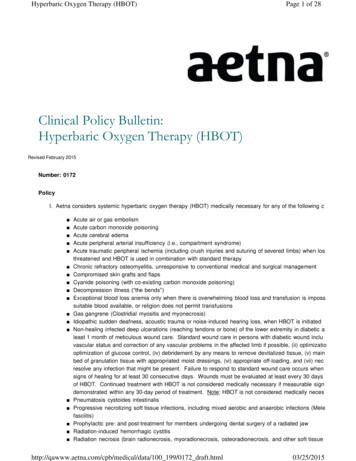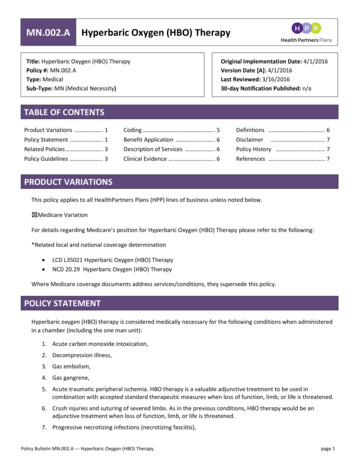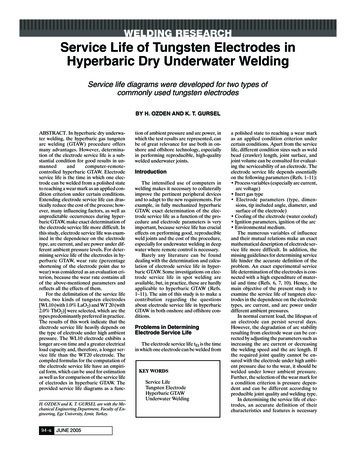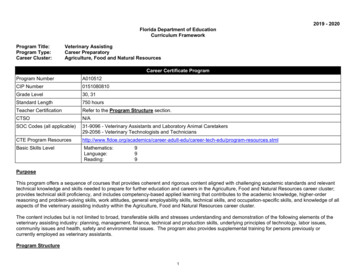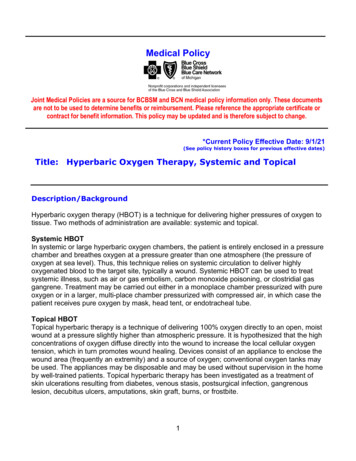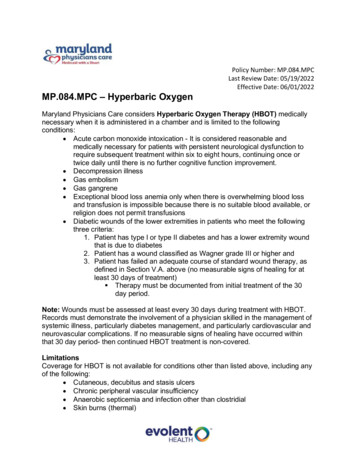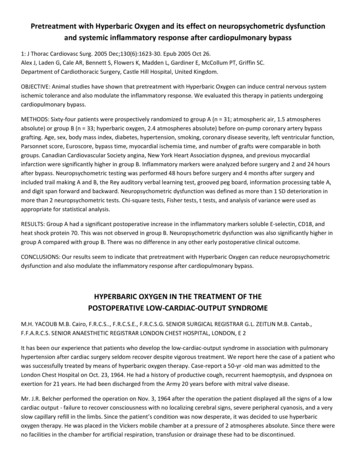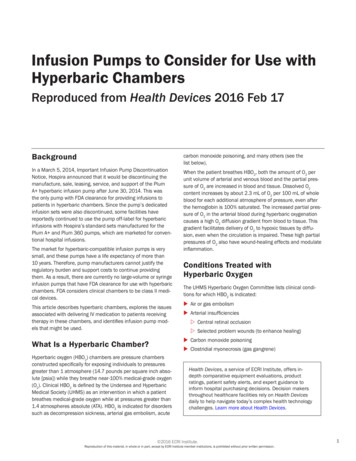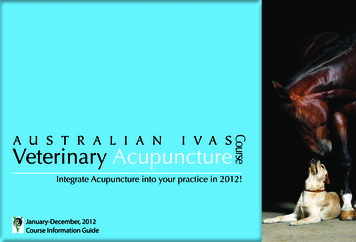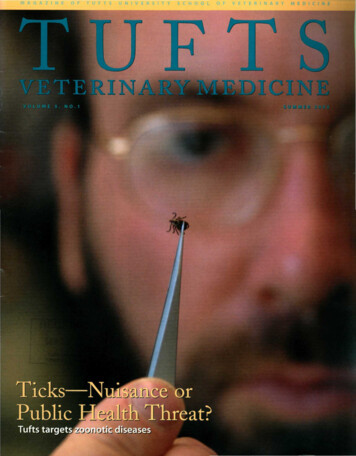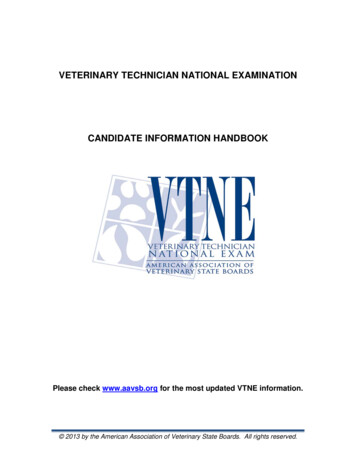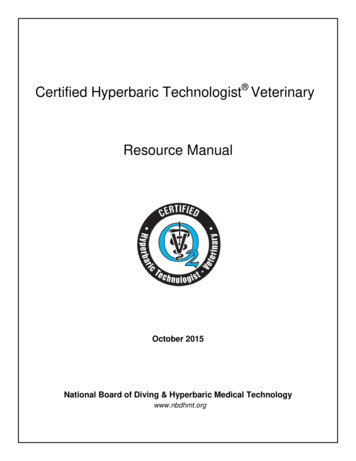
Transcription
Certified Hyperbaric Technologist VeterinaryResource ManualOctober 2015National Board of Diving & Hyperbaric Medical Technologywww.nbdhmt.org
Table of ContentsSCOPE OF PRACTICE .1Purpose .1Goal .1Objectives .1Competency Domains .1Certification Process .2Certification Maintenance - Recertification.2Clinical Internship.3GENERAL KNOWLEDGE COMPETENCIES .3Competency Domains .3Competencies .3Chamber operations .7INTERNSHIP GUIDELINES AND COMPETENCIES .9Hyperbaric facility orientation .9Generalized Clinical Knowledge .9Chamber Equipment .10Patient Assessment .10Patient Preparation & Hyperbaric Treatment .11Chamber Operations .12i
SCOPE OF PRACTICEPurposeThe purpose of certification in veterinary hyperbaric medicine (Certified HyperbaricTechnologist – Veterinary; CHT-V) is to promote the safe and successful management ofanimals in the hyperbaric environment.GoalThe goal is to develop a certification program in veterinary hyperbaric medical technology (CHTV) to assure that the discipline of hyperbaric medicine is supported by appropriately qualifiedveterinary technologists and/or veterinarians.Objectives1. To develop minimum core competencies in veterinary hyperbaric medicinetechnology.2. To develop appropriate standards or guidelines for training course curricula andclinical internships.3. To develop a process for certification in veterinary hyperbaric medicine.a. Pre-requisites1) Qualifications, credentialsb. Examinationc. Continuous process evaluationd. Post process professional development and continued certificationCompetencies are defined as the ability to do something and usually require the application ofcomplex and integrated knowledge and skill sets.Competency Domains1. Essential physics and physiology of gases and pressure, and their application.2. Direct and indirect effects of pressure changes and their recognition andmanagement in animals.3. Basic animal behavior, animal management, normal physical parameters.4. Basic anatomy and physiology of animal species.5. Indications and contraindications for the use of hyperbaric oxygen therapy inanimals and mechanism(s) of action in each indication.6. Gas systems and animal hyperbaric chamber operation.7. Hyperbaric chamber and facility safety.1
Certification Process1. Credentialsa. Qualifying vocations Veterinarian DVMVeterinary TechnicianVeterinary AssistantVeterinary TechnologistsAnimal Science TechnicianMedical Services SpecialistMedical Doctor, MDEMT, EMT-I or ParamedicRegistered Nurse or LPNCHTb. Be at least 18 years of age with a high school diploma or equivalent2. Qualificationsa. The CHT-V candidate must have completed a National Board of Diving andHyperbaric Medical Technology (NBDHMT) approved hyperbaric medicineintroductory course.b. The CHT-V candidate must meet a minimum clinical internship of 120 hours ofundersea, hyperbaric medicine or aviation medicine technology which mustinclude at least 40 hours of Supervised Clinical Internship, including the nameof the intern and the name of the preceptor on company letter head, alongwith signatures and 80 hrs of experience in a veterinary facility.3. Successful completion of the CHT-V certifying examination. The examination includesthe appropriate evaluation of competencies related to veterinary and animal hyperbaricmedicine. The examination will also assess those competencies common to both humanand animal hyperbaric disciplines.Certification Maintenance - Recertification1. Maintain a minimum 12 continuing education credits every two years with at least six(6) of those specific to undersea hyperbaric medicine chamber safety.2. The employer, administrator or medical director must provide a letter ofrecommendation and verification of 100 hours minimum of continued experience inundersea or hyperbaric medicine.2
Clinical InternshipClinical Internship – Guidelines for internship curricula and experiences.Qualifications for Internship:1. Be at least 18 years of age with a high school diploma or equivalent (internationalschooling will be recognized).2. The CHT-V applicant must have completed a National Board of Diving and HyperbaricMedical Technology (NBDHMT) approved hyperbaric medicine introductory course priorto enrolling in the internship.Competencies: General Knowledge Facility Orientation Chamber Equipment Patient Assessment Patient Preparation and Hyperbaric Treatment Chamber Operations and SafetyGENERAL KNOWLEDGE COMPETENCIESCompetency Domains Essential physics and physiology of gases and pressure and their application inhyperbaric medicine. Proper application of hyperbaric oxygen therapy requires athorough knowledge and understanding of the physics and physiology associated withincreased pressure. The physical and physiologic concepts are important inunderstanding how hyperbaric oxygen therapy works, the problems that can develop inthe body with increasing pressures and oxygen and the mechanisms by which hyperbaricoxygen therapy is beneficial in the management of disease.Competencies Units of pressure used in diving and hyperbaric oxygen therapy and conversion of oneunit to another.Terminology used in hyperbaric oxygen therapy.Knowledge of the important gas laws associated with pressure and their application inhyperbaric therapy.Boyle’s Law (calculating air volumes and air consumption).Dalton’s Law (partial pressure of gases at various depths, alveolar oxygenconcentration).Charles’ Law (the relationship between pressure changes and temperaturechanges).Henry’s Law (the effect of partial pressures on the solubility of various gases in liquidsand their corresponding effects on decompression).3
The principles of heat transfer by conduction, convection and radiation.Define conduction, convection and radiation.Explain how these concepts are related to hyperbaric therapy.Barotrauma – direct and indirect effects of pressure change. Barotrauma can resultfrom the physical and physiologic effects of pressure applied during hyperbaric oxygentherapy. Identification, prevention and/or management of barotrauma events is animportant aspect of the placing patients in a hyperbaric environment. Recognition andmanagement of pressure related problems in animals.Define barotrauma (direct effects of changing ambient pressure).Explain the physical laws of gas behavior that contribute or are related to thedevelopment of barotrauma.List the most common sites for the occurrence of barotrauma.For each site of barotrauma be able to describe the following aspects:o Time of occurrenceo Physiology and pathophysiology of the syndromeo Signs and symptoms in animalso Treatmento Prevention and treatmentIndirect effects of pressure – list the most common indirect effects of pressure.For each effect describe the following aspects:o Physiology and pathophysiology of the syndromeo Signs and symptoms in animalso Patient managemento Treatmento PreventionPossess the capability to provide clinical support and assist in the prevention and/ormanagement of pressure related problems.Squeeze and other barotraumas.Carbon dioxide (CO2) retention.Carbon monoxide (CO) poisoning.Hyperbaric chamber gas contamination.Anoxic and hypoxic events.Hypothermic and hyperthermic events.Effects of elevated partial pressures of oxygen.Review Dalton’s Law.Know the signs of oxygen toxicity.Acute toxicity.Chronic toxicity.Possess the capability to provide clinical support and assist in the prevention and/ormanagement of toxicity due to high oxygen partial pressure in various species.Relevant basic anatomy and physiology of animal species pertaining to the followingsystems. Knowledge of animal structure and function is key in understanding normal and4
abnormal states and in managing disease. These basics are also important in monitoringand managing the effects of pressure and hyperoxia in the hyperbaric patient.Species:o Basico Canineo Felineo Equineo Others (bovine, caprine, porcine, camelid, avian, reptile, other exotic)Systems:o Musculoskeletalo Neurologicalo Integumentaryo Cardiovascularo RespiratoryIndications and contraindications for the use of hyperbaric therapy in animals and themechanism(s) of action in each indication. The hyperbaric technician should be able tolist the indications for hyperbaric therapy and what effects of hyperbaric therapy arebeneficial for these indications. Knowledge of the general mechanisms and affects ofhyperbaric oxygen is necessary to discuss the efficacy in disease processes. Thehyperbaric technician should be able to list and discuss the mechanisms associated withcontraindications for use of hyperbaric therapy in animals.General mechanisms and physiologic effects of hyperbaric oxygen therapy.Cardiovascular effects.Pulmonary system.Immune system including effects on infectious agents.Wound healing and tissue salvage.Bone repair.Central nervous system effects.Oxygen radical production.Ophthalmic system.Indications for use of hyperbaric oxygen therapy in animals.Veterinarians and veterinary technicians should know the UHMS approved indications forhumans (all apply to animals except maybe DCS).Animal related indications:5
Discuss understanding of rationale for hyperbaric oxygen therapy treatment in thesevarious conditions.List expected benefits for conditions and indications.Contraindications for the use of hyperbaric oxygen therapy in animals. Contraindicationsmay be categorized as absolute or relative (based on human criteria).Absolute contraindications.Untreated pneumothorax.Untreated guttural pouch disease in equidae.Untreated middle and external ear diseases.Relative contraindications.High fever.Viral infections.Previous thoracic surgery.Previous spontaneous pneumothorax.Emphysema plus CO2 retention.Seizure disorders.Chronic sinusitis and other upper respiratory infections.Optic neuritis.Certain drugs – doxorubicin, bleomycin, disulfiram, cis-platinum, mafenide acetate.Gas systems and animal hyperbaric chamber operation. The certified hyperbarictechnician should have a thorough knowledge of hyperbaric chambers and should beable to demonstrate basic chamber operation including patient evaluation andpreparation.Classification of chambers and identification of the basic components of any hyperbaricchamber.Be familiar with NFPA classifications for hyperbaric chambers (A,B,C,) and how thisapplies to hyperbaric chambers used in veterinary medicine.6
Be able to describe the basic common components of a hyperbaric chamber, theirpurpose or use.Gases and gas quality.Oxygen purity and its importance.Methods for identifying gas impurities.Principles and use of gas analyzers.Calibrate gas analyzers.Gas line filtration.Be able to follow supply gas lines and describe components associated with them; tracesupply gases from origin the patient.Understand and/or conduct procedures for chamber operations and life supportsystems.Elemental gas schematics and their interactions when mixed.Mathematical calculations of gas usage.Know how to prepare an animal patient for hyperbaric therapy including:o a review of the patient’s history, medical/surgical condition as it might beaffected by hyperbaric conditions.o evaluation of current treatments, medications etc. as they might be affected by oraffect hyperbaric therapy.o be able to assure that they are not “no go” substances, materials etc. associatedwith the patient prior to therapy.o be able to conduct a pre therapy examination of the patients physical status(TPR), etc.Chamber operations Appreciate the unique differences between monoplace and multiplace chambers.The various substances and materials, which are prohibited inside a chamber, such asmedical preparations, combustible materials, etc.Pre and post dive checks of a hyperbaric chamber complex using specific checklists.The monitoring of internal chamber operations.Monitor the chamber for depth, temperature and humidity using available types ofequipment.Rationale for gas stratification and its prevention.The principles of operation of various items of equipment used in a typical hyperbaricsystem, such as compressors, fire suppression systems, oxygen supply.How to carry out normal operations, and basic inspections of gas and air systems.Treatment protocols and procedures for multiple indications. Risks/benefits involvedwith emergency decompression.Proper identification of various gas cylinders; mandatory hospital grade gases and properhandling and storage of gas cylinders.The checks and user maintenance needed after using a hyperbaric chamber.Maintain a legible and accurate record of all aspects of a hyperbaric system.7
The characteristics of and maintenance requirements for acrylic viewpoints/cylinders.Emergency preparedness for fire, loss of oxygen, medical complications.The use of various types of fire suppression systems including routine maintenance andoperational checks.Familiarity with the following regulatory agencies and other related organizations:o Food and Drug Administration (FDA)o Occupational, Safety and Health Administration (OSHA)o National Fire Protection Association (NFPA)o American Society of Mechanical Engineers (ASME)o American Society of Mechanical Engineers’ Committee on Pressureo Vessels for Human Occupancy (ASME PVHO)o Veterinary Hyperbaric Medicine Society (VHMS)o Undersea and Hyperbaric Medical Society (UHMS)o Other governing bodies in state of operation; including veterinary, racing andperformanceThe certified hyperbaric technician should be able to demonstrate a thorough knowledgeof chamber and facility safety.Basics of fire safety.Explain components of fire.Explain differences of fire in the hyperbaric oxygen environment.Define ignition temperature and flash point.Know possible sources of ignition in a hyperbaric chamber.Know basic methods for fire prevention in and outside the chamber.Basics of operational chamber safety.Vessel integrity.Handling of compressed gases.Electrical safety and grounding.HBOT staff training and qualifications.Safety standards.How to develop a “GO – NO - GO” list and apply risk assessment operational safety. Thedecision tree.Infection control.Know and demonstrate knowledge of standard universal precautions.Recognize patient and equipment risk factors for cross-contamination.Describe care and cleaning of hyperbaric chambers.State reasons for cleanliness in the hyperbaric facility.8
INTERNSHIP GUIDELINES AND COMPETENCIESHyperbaric facility orientation1. Reviews and understands the hyperbaric Safety Manual for the facility2. Completes hyperbaric facility tour3. Identifies location of emergency procedures guidelines4. Identifies location of personal protective equipment5. Identifies location of hyperbaric log and maintenance books6. Identifies location of no smoking / oxygen in use signs7. Identifies location of operator breathing source/mask for each chamber8. Demonstrates how to access facility fire alarm system9. Identify backup system for electrical failure10. Identify bulk oxygen storage tank and surrounding area11. Identify patient education for hyperbaric treatments12. List items allowed/not allowed in hyperbaric chamber13. State requirements for fire drills14. Hyperbaric therapy facility policy review. The candidate should be familiar with and beable to state the policy for: Hyperbaric physician and operator presence during hyperbaric treatment Role and duties of the Safety Director Policy on gas handling Policy on gas storage Policy on storage of hazardous materials Policy for housekeeping in hyperbaric area Policy for smoking in the chamber area15. State requirements for ongoing safety education.Generalized Clinical Knowledge1. Have a basic understanding of the risks, side effects and hazards of certain medications inthe hyperbaric chamber.2. Describe the signs, symptoms and treatment of hyper- and hypothermia3. Describe the effects of gases on the body and their limits under pressure4. Describe the effects of pressure on the body and the principles of decompression andtherapeutic procedures5. Safe animal handling skills.6. Have relevant knowledge to communicate with all levels of hyperbaric medical team(including techs, Dr’s, etc).7. Patient assessment9
8. Basic medical terminology9. Medical record keeping, including documentation such as photographs, videos, woundmeasurements, labeling, etc.Chamber Equipment1.2.3.4.5.Know and demonstrate knowledge of the routing of the compressed gas supplyDemonstrate emergency shut-off procedures on chamberDemonstrate use of and the reason for adjusting the flow meter during HBO treatmentShow location of exhaust valve on outside wallDemonstrate acrylic inspection and documentation; know the characteristics of andmaintenance requirements for acrylic viewports/cylinders.6. Identify stamp on HBO chamber per ANSI/ASME PVHO PVHO-1 standard7. Identify oxygen level gauge8. Verify integrity of chamber ground wire9. Verify integrity of patient grounding strap10. Gas handing:a. Contents of compressed gas cylinders are legibly marked on the exterior ofcylinderb. High pressure gas cylinders are stored in assigned locations and accessible only toauthorized personnelc. Hi pressure gas cylinders are not stored near flammable materialsd. Large gas cylinders are stored in such a manner that they are restrained frombeing knocked overe. Large gas cylinders are transported by the use of a hand truck that provides ameans of restraining the cylinderf. Valve protection valves are in placeg. Pressure reducing regulators are used to reduce the pressure from the cylinder tothe supply lineh. PPE used when handling liquid oxygen cylinders11. Demonstrates working knowledge of hyperbaric regulatory guidelines to include ASMEPVHO, ANSI, CGA CFR, NFPA, TJC, UHMS.12. Demonstrate completion of daily, weekly, monthly, semiannual and annual maintenancelogs.Patient Assessment1. Know and demonstrate knowledge of current appropriate referral conditions forhyperbaric oxygen treatment.2. Demonstrate knowledge of treatment plan and know the duties of each staff memberinvolved and discuss and understand the rationale for treatment plan.10
3. Review patient's reason for referral.4. Demonstrate knowledge of side-effects of hyperbaric therapy (see 2.0 undercompetencies). Knows species variations.5. Have a basic understanding in the operation of biomedical devices within your facility.6. Be able to carry out relevant diagnostic and clinical procedures such as:a. Ability to report to supervising medical personal an accurate medical historyb. Blood glucose levelsc. Assess patient for pain and documentd. Obtain vital signs, pulse, respiratory rate, body temperature.e. Observe for changes in neurological statusf. Know when to use appropriate clean or sterile techniquesg. Collection and removal of patient waste productsh. Assist in patient care procedures; dressing changes etci. Prepare patient for treatment: Safe loading and unloading of patients Ensure ONLY approved materials for inside chamber use Provide comfort measures within approved safety constraints. Comply with all facility quality control measuresPatient Preparation & Hyperbaric Treatment1. Demonstrates knowledge of animal behavior that might indicate anxiety and fear ofbeing placed in a chamber and behavior that might lead to potential for injury duringplacement or treatment in the chamber. Demonstrates knowledge of anxiety and fearrelated to feelings of confinement anxiety associated with hyperbaric chamber.2. Demonstrates knowledge of potential for oxygen toxicity related to delivery of 100%oxygen at an increased atmospheric pressure3. Demonstrates basic knowledge pain related to associated medical problems4. Demonstrates knowledge of discomfort related to temperature and humidity changesinside hyperbaric chamber5. Barotrauma Managementa. Know and demonstrate knowledge of the signs and symptoms of barotrauma invarious species.b. Know and demonstrate knowledge of the immediate management ofbarotrauma.6. Oxygen Toxicity Managementa. Know and demonstrate knowledge of the signs and symptoms of central nervoussystem intolerance to hyperbaric doses oxygen.b. Know and demonstrate knowledge of the signs and symptoms of pulmonaryoxygen toxicity.11
c. Know and demonstrate knowledge of the various methods that serve to reducethe likelihood of immediate management of CNS toxicity.d. List the complicating factors associated with the development of pulmonaryoxygen toxicity.7. Pulmonary Barotraumaa. Know and demonstrate knowledge of risk factors for pulmonary barotraumas onascent.b. Know and demonstrate knowledge of immediate management of suspectedpulmonary barotrauma on ascentc. State the differential diagnosis of: cerebral arterial gas embolism pneumothorax tension pneumothorax mediastinal emphysema subcutaneous emphysema8. Cardiopulmonary Complicationsa. Proficiency in obtaining vital signsb. Knowledge of common clinical signs of severe, acute onset, cardiovasculardistress.c. Proficiency in basic CPR9. Wound Carea. Appreciate the general principles of wound homeostasis, infection control andtreatment and wound healing and non-surgical wound care.b. Assist in the evaluation of woundsc. Assist in the limited debridement of wounds, wound dressings and theirrespective applications.10. Documentationa. Demonstrates understanding of documentation requirementsb. Know and demonstrate knowledge of all forms, electronic medical record, andpaperwork used to document patient treatment.c. Complete pre-treatment patient assessment and treatment protocol forms.d. Complete ancillary patient chart notes and post treatment documentation.e. Complete a record of a typical patient hyperbaric treatment.f. Demonstrate completion of daily patient treatment logs per chamber.Chamber Operations1. Chamber Standard Operating Procedures2. Demonstrate inspection and understanding of chamber console panel layout3. Locate and operate automatic controls4. Locate and operate manual controls12
5. Demonstrate compression and decompression of the chamber6. Checklists, Dive Tables and Treatment Protocolsa. Demonstrate knowledge of chamber checklistsb. Demonstrate knowledge of patient checklistsc. Demonstrate knowledge of decompression tablesd. Demonstrate knowledge of decompression protocolse. Demonstrate knowledge of decompression table computations7. Inspection of acrylic after each hyperbaric treatment for signs of drainage- if present, clean chamber prior to next treatment.8. State when chambers are to be cleaned.9. Pressure Safetya. Know and demonstrate knowledge of correct procedure for operating/securingdoor of chamber.b. Know proper set-up and connection of all pass-throughsc. List the potential pressure hazards in and around the chamberd. Demonstrate operation of all pressure boundary doors.10. Infection Controla. Know and demonstrate knowledge of standard universal precautions. Use of approved disinfectants for chamber and equipment; recognizingthe risks associated with off gassing of chemicals in the chamber. Hand washing Personal protective equipment (PPE)b. Recognize patient and equipment risk factors for cross-contaminationc. Demonstrate care and cleaning of hyperbaric chamber.d. Demonstrate care and cleaning of hyperbaric stretchere. State reasons for cleanliness in hyperbaric area.11. Chamber Standard Operating Proceduresa. Know console/panel layout as it pertains to emergency and override controls.b. State reasons to use emergency decompression button.c. State proper way to use emergency decompression button.12. Fire Safetya. Demonstrate knowledge of possible ignition sourcesb. List items not allowed in hyperbaric chamberc. Demonstrate knowledge for fire emergency in chamber in immediate area of chamber in hyperbaric room in facilityd. Fire Extinguishing System Know location of fire extinguishers and fire alarms. Demonstrate use of portable fire extinguisher13
Technologist - Veterinary; CHT-V) is to promote the safe and successful management of . Define conduction, convection and radiation. Explain how these concepts are related to hyperbaric therapy. . o a review of the patient's history, medical/surgical condition as it might be affected by hyperbaric conditions.
